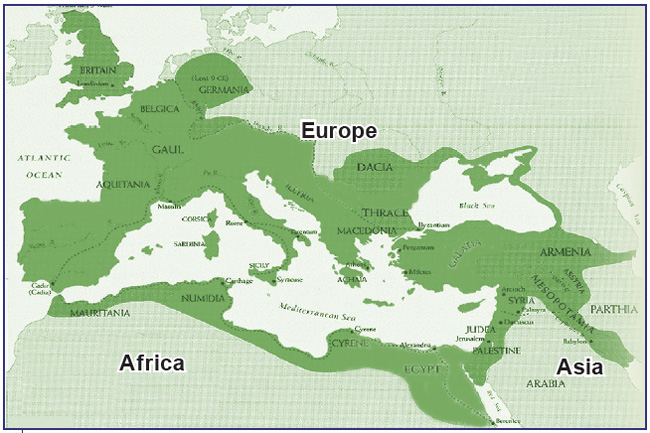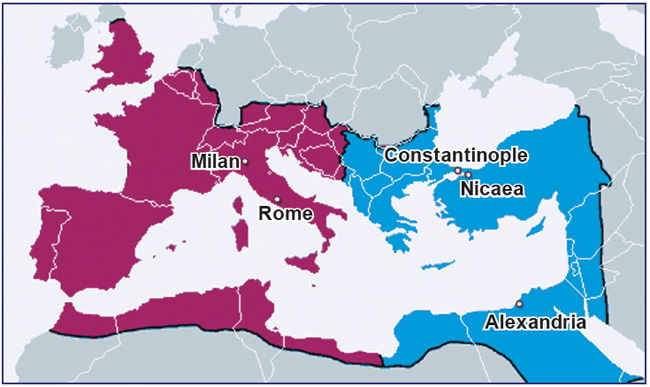| |
|
| |
 |
[Special] Christianity Became the State Religion of the Roman Empire; The Edict of Milan; and the Nicene Creed
|
|
|
 12201 |
 |
May 15, 2011 |
|
|
|

After the resurrection and ascension of the Lord, Christianity was rapidly spread in all Judea and Samaria and even in Asia and Europe. Churches experienced great revival, however many of the churches were destroyed due to the severe persecution inflicted by the emperors of the Roman Empire. They took the Bible away from Christians, deprived them of their status and rights, imprisoned them, and even killed many of them up until the beginning of 4th century.
[History of Persecution of Christians in the Roman Empire]
Names of the Emperors / Period of Reign
1. Nero (37-68)
2. Domitian (89-96)
3. Trajan (98-117)
4. Hadrian (117-138)
5. Marcus Aurelius (161-180)
6. Septimius Severus (193-211)
7. Maximian (235-238)
8. Decius(249-251)
9. Valerian (253-260)
10. Diocletian (284-305)
Constantine the Great was the first Roman emperor to convert to Christianity. By issuing the Edict of Milan in 313, he brought the end of persecution of Christians. He convened Councils of Nicaea as his effort to attain consensus in the church. He became the absolute ruler in both the Eastern and Western Roman Empires through several campaigns. He had the spiritual experience of meeting the Lord, so he protected and encouraged Christianity enthusiastically.
* The Edict of Milan: Bringing an End to the Persecution of Christians in the Roman Empire
The persecution of Christians in the Roman Empire began in the first century and continued over a period of about three centuries until the time of Diocletian. (See the table on the left). The territory of the Roman Empire was so vast that one emperor could not govern the whole territory. The empire was divided along an East/West Axis and governed by two emperors. Diocletian divided the Empire again, appointing two Caesars (junior emperors) to govern further subdivisions of the East and West. Each would be subordinate to their respective Augustus (senior emperor). This system is called the Tetrarchy.
After the death of the Emperor Diocletian, the political unrest arose and the fight for power among the emperors broke out. In the end, however, in 312 Constantine defeated Maxentius' rebel forces and became the sole emperor in the Western Roman Empire. He believed that he owed his success to Jesus Christ. (Refer to Manmin News No. 229 'The History of Christianity Embedded in the Elliptical Amphitheatre, Coliseum' on the third page).
In 313, he met with Licinius, the absolute emperor over the Eastern Roman Empire, in Mediolanum (present-day Milano) to discuss pending issues about their politics and ruling systems. During this meeting, the emperors agreed on the Edict of Milan, officially legalizing Christianity and granting restoration for all property to Christians. Through the edict, Christians were given back all their private and public property seized during the persecutions. This also returned confiscated Church property. Christianity was legally endowed with the status equivalent of other religions.
Unlike Licinius, Constantine actively managed religious policies in ways that protected and encouraged Christianity. He guaranteed financial and legal privilege for churches and ministers and abolished various customs and legislation which insulted Christians. He tried to emancipate Christian slaves, legalize the donation of legacy to churches, and designated Sundays as national holidays. In other words, the Edict of Milan put an end to the long-lasting persecution of Christians in the Roman Empire.
* The First Council of Nicaea: Reaffirming the Divinity of Jesus Christ
The Roman Empire's great persecution towards Christianity terminated during the reign of Constantine. When this external problem of persecution ended, however, internal problems occurred in Christianity. It was concerning the controversies over the doctrines of Christianity. The most controversial thesis during the early churches was concerning the divinity of Jesus Christ. The controversy on the divinity of Jesus Christ lasted for a couple of centuries.
The most crucial controversy was from Arius. Arius, who was from Libya and an elder of the church in Alexandria, led an enthusiastic and ascetic life and many followers supported his doctrine. Arian group raised a few serious questions in regard to the divinity, substance and eternity of Jesus Christ and many eastern orthodox churches followed their contention. On the other hand, Athanasius, who ministered to the church in Alexandria, asserted that Jesus Christ and God is one in substance, and Jesus Christ is fully God and fully man.
At the first Nicene Council held by Constantine in 325, Athanasius made a great contribution to the establishing of the Nicene Creed. The Nicene Council declared the Nicene Creed through the combination of the assertion of Athanasius of Alexandria and that of Eusebius of Caesarea. This Nicene Creed is considered as one of the foremost statements of the tenets of the Christian confession of faith. Together with the Apostles' Creed it presents to the believers in the Christ the most fundamental doctrines of Christianity.
This Nicene Creed was revised with some additions at the First Council of Constantinople held in 381, and after this council the Arian contentions were completely expelled, and thus the 50-year controversy over the Triune God came to a close.
Map 1

Map 2

(Map 1) In 117, the Gospel, coming from Israel could be spread all over the world so rapidly because the Roman Empire had the greatest expanse of territory in the world with the Mediterranean at its center. In 330, Constantine the Great (306-337) changed the capital city from Rome to Byzantium, which he called 'New Rome.' It was also called Constantinople (present-day Istanbul, Turkey) named after Constantine.
(Map 2) In 392, Theodosius the Great (379-395) made Christianity the official state religion of the Roman Empire during his reign. Theodosius was the last emperor to rule over both the eastern and the western halves of the Roman Empire. In 476, the western half of the Roman Empire that had Rome in its center, fell. In 1453 the eastern half of the Roman Empire having Constantinople in its center, also fell.
|
|
|
 |
|
|
|
|

